Audit Report on Trunkey Creek Wines Ltd: Risk & Ratio Analysis
VerifiedAdded on 2023/06/09
|18
|4452
|202
Report
AI Summary
This report provides an analysis of the audit risks associated with Trunkey Creek Wines Limited (TCW), focusing on key accounts such as accounts receivable, investments, property assets, and marketing expenses. It uses ratio analysis to assess the company's financial performance and identifies potential areas of material misstatement due to error or fraud. The report also evaluates the effectiveness of TCW's internal controls in ensuring operational efficiency and compliance with organizational objectives. Key performance indicators, including return on equity, return on assets, gross margin, and days in inventory, are analyzed to provide a comprehensive overview of TCW's financial health and potential business risks. The analysis includes a review of both audited historical data and unaudited projections to identify trends and potential areas of concern for the auditor.
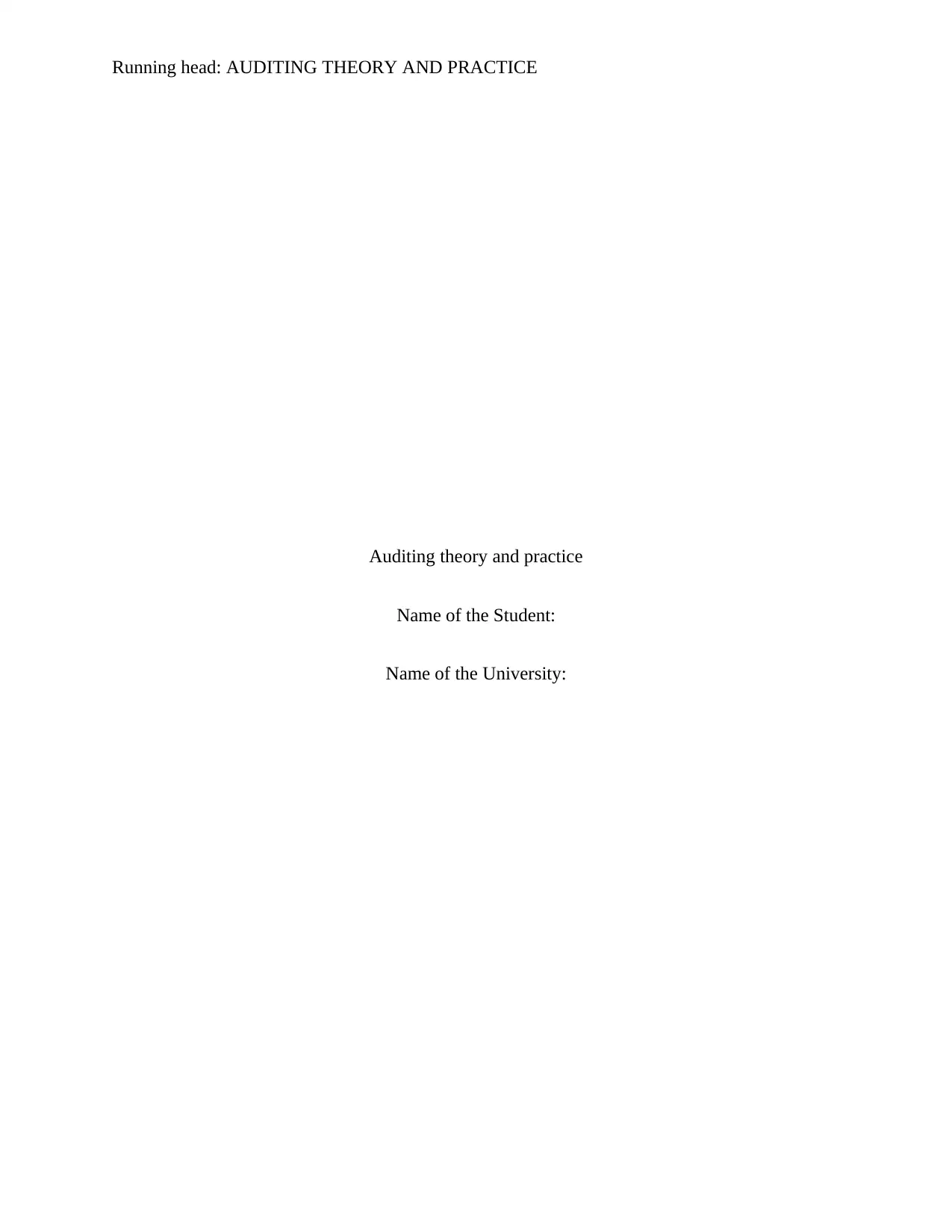
Running head: AUDITING THEORY AND PRACTICE
Auditing theory and practice
Name of the Student:
Name of the University:
Auditing theory and practice
Name of the Student:
Name of the University:
Paraphrase This Document
Need a fresh take? Get an instant paraphrase of this document with our AI Paraphraser
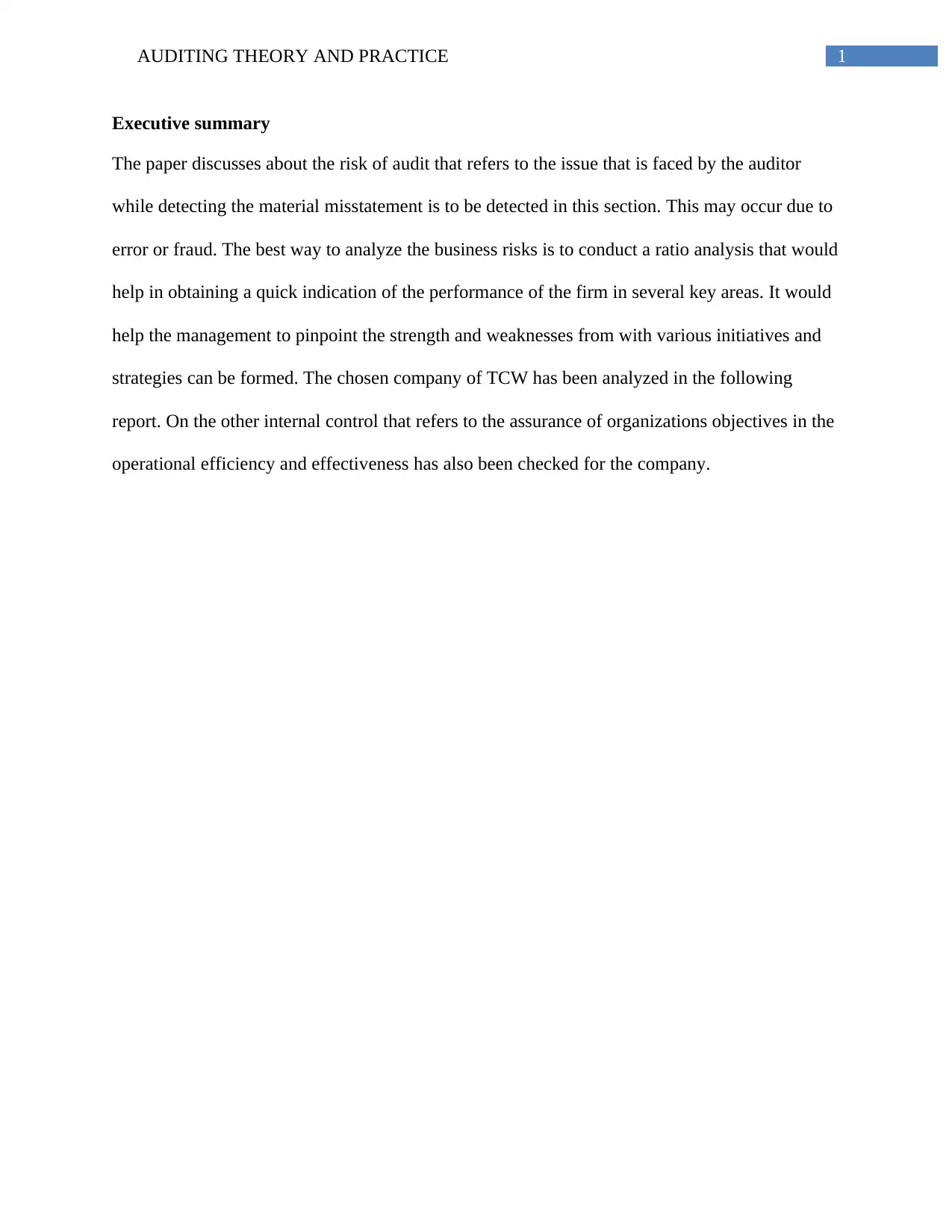
1AUDITING THEORY AND PRACTICE
Executive summary
The paper discusses about the risk of audit that refers to the issue that is faced by the auditor
while detecting the material misstatement is to be detected in this section. This may occur due to
error or fraud. The best way to analyze the business risks is to conduct a ratio analysis that would
help in obtaining a quick indication of the performance of the firm in several key areas. It would
help the management to pinpoint the strength and weaknesses from with various initiatives and
strategies can be formed. The chosen company of TCW has been analyzed in the following
report. On the other internal control that refers to the assurance of organizations objectives in the
operational efficiency and effectiveness has also been checked for the company.
Executive summary
The paper discusses about the risk of audit that refers to the issue that is faced by the auditor
while detecting the material misstatement is to be detected in this section. This may occur due to
error or fraud. The best way to analyze the business risks is to conduct a ratio analysis that would
help in obtaining a quick indication of the performance of the firm in several key areas. It would
help the management to pinpoint the strength and weaknesses from with various initiatives and
strategies can be formed. The chosen company of TCW has been analyzed in the following
report. On the other internal control that refers to the assurance of organizations objectives in the
operational efficiency and effectiveness has also been checked for the company.
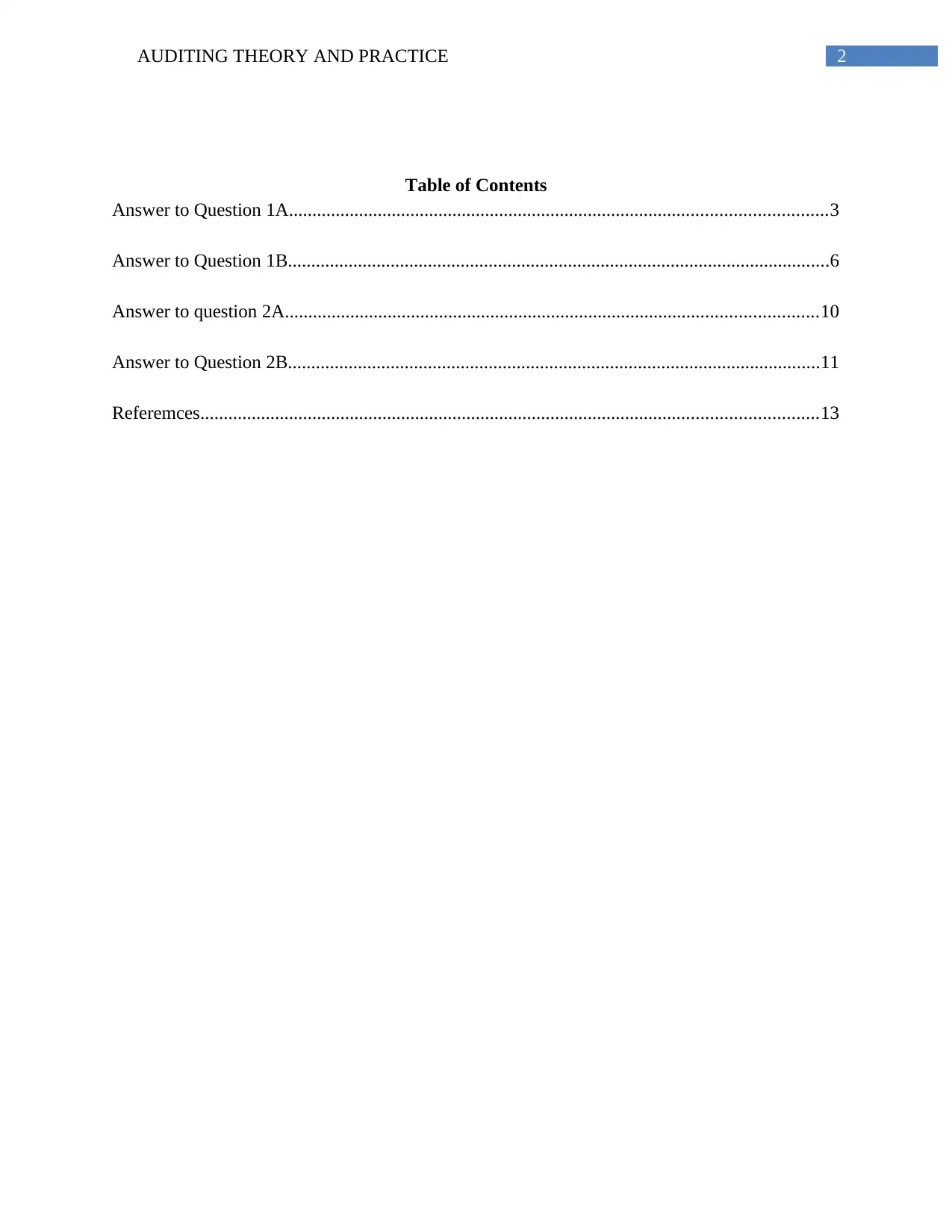
2AUDITING THEORY AND PRACTICE
Table of Contents
Answer to Question 1A...................................................................................................................3
Answer to Question 1B....................................................................................................................6
Answer to question 2A..................................................................................................................10
Answer to Question 2B..................................................................................................................11
Referemces....................................................................................................................................13
Table of Contents
Answer to Question 1A...................................................................................................................3
Answer to Question 1B....................................................................................................................6
Answer to question 2A..................................................................................................................10
Answer to Question 2B..................................................................................................................11
Referemces....................................................................................................................................13
⊘ This is a preview!⊘
Do you want full access?
Subscribe today to unlock all pages.

Trusted by 1+ million students worldwide
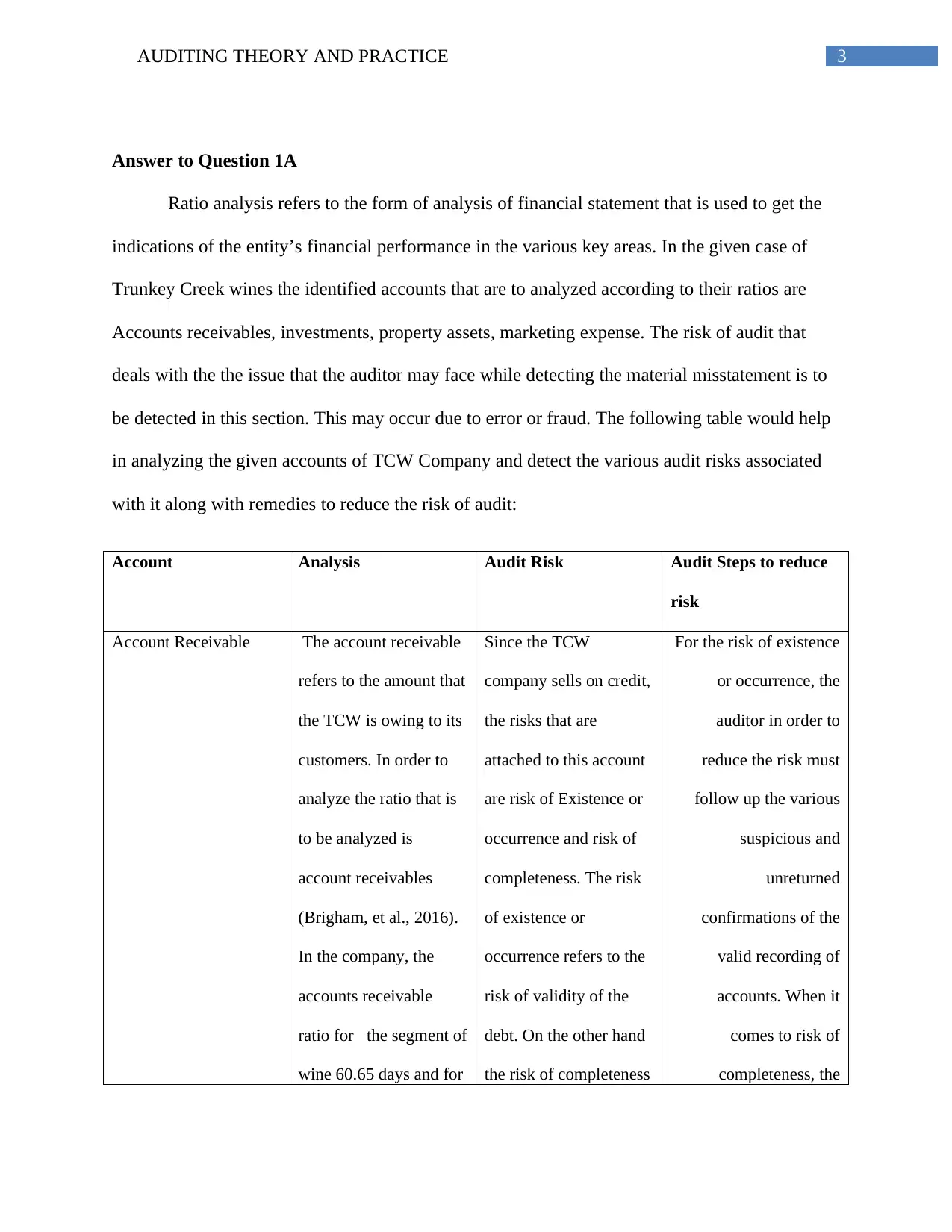
3AUDITING THEORY AND PRACTICE
Answer to Question 1A
Ratio analysis refers to the form of analysis of financial statement that is used to get the
indications of the entity’s financial performance in the various key areas. In the given case of
Trunkey Creek wines the identified accounts that are to analyzed according to their ratios are
Accounts receivables, investments, property assets, marketing expense. The risk of audit that
deals with the the issue that the auditor may face while detecting the material misstatement is to
be detected in this section. This may occur due to error or fraud. The following table would help
in analyzing the given accounts of TCW Company and detect the various audit risks associated
with it along with remedies to reduce the risk of audit:
Account Analysis Audit Risk Audit Steps to reduce
risk
Account Receivable The account receivable
refers to the amount that
the TCW is owing to its
customers. In order to
analyze the ratio that is
to be analyzed is
account receivables
(Brigham, et al., 2016).
In the company, the
accounts receivable
ratio for the segment of
wine 60.65 days and for
Since the TCW
company sells on credit,
the risks that are
attached to this account
are risk of Existence or
occurrence and risk of
completeness. The risk
of existence or
occurrence refers to the
risk of validity of the
debt. On the other hand
the risk of completeness
For the risk of existence
or occurrence, the
auditor in order to
reduce the risk must
follow up the various
suspicious and
unreturned
confirmations of the
valid recording of
accounts. When it
comes to risk of
completeness, the
Answer to Question 1A
Ratio analysis refers to the form of analysis of financial statement that is used to get the
indications of the entity’s financial performance in the various key areas. In the given case of
Trunkey Creek wines the identified accounts that are to analyzed according to their ratios are
Accounts receivables, investments, property assets, marketing expense. The risk of audit that
deals with the the issue that the auditor may face while detecting the material misstatement is to
be detected in this section. This may occur due to error or fraud. The following table would help
in analyzing the given accounts of TCW Company and detect the various audit risks associated
with it along with remedies to reduce the risk of audit:
Account Analysis Audit Risk Audit Steps to reduce
risk
Account Receivable The account receivable
refers to the amount that
the TCW is owing to its
customers. In order to
analyze the ratio that is
to be analyzed is
account receivables
(Brigham, et al., 2016).
In the company, the
accounts receivable
ratio for the segment of
wine 60.65 days and for
Since the TCW
company sells on credit,
the risks that are
attached to this account
are risk of Existence or
occurrence and risk of
completeness. The risk
of existence or
occurrence refers to the
risk of validity of the
debt. On the other hand
the risk of completeness
For the risk of existence
or occurrence, the
auditor in order to
reduce the risk must
follow up the various
suspicious and
unreturned
confirmations of the
valid recording of
accounts. When it
comes to risk of
completeness, the
Paraphrase This Document
Need a fresh take? Get an instant paraphrase of this document with our AI Paraphraser
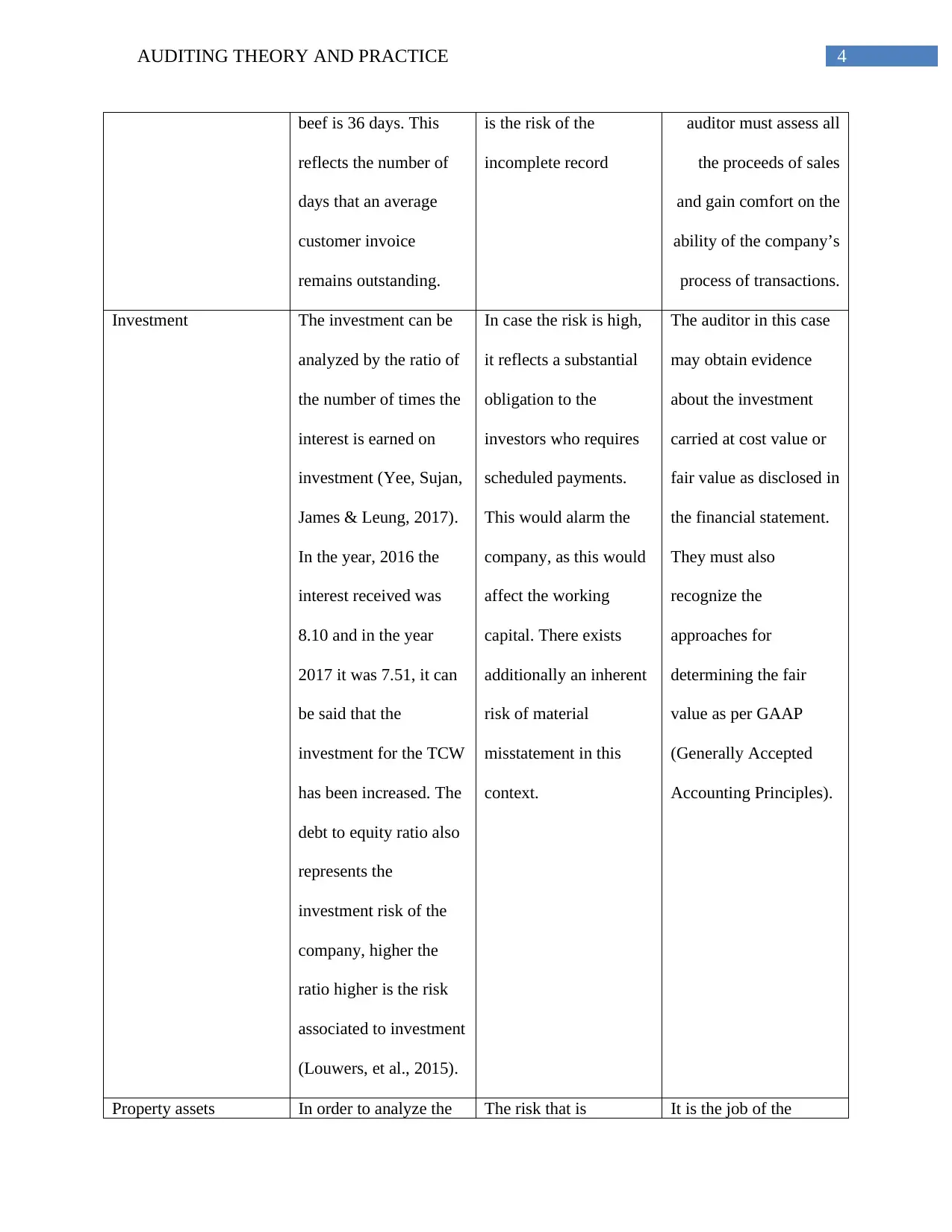
4AUDITING THEORY AND PRACTICE
beef is 36 days. This
reflects the number of
days that an average
customer invoice
remains outstanding.
is the risk of the
incomplete record
auditor must assess all
the proceeds of sales
and gain comfort on the
ability of the company’s
process of transactions.
Investment The investment can be
analyzed by the ratio of
the number of times the
interest is earned on
investment (Yee, Sujan,
James & Leung, 2017).
In the year, 2016 the
interest received was
8.10 and in the year
2017 it was 7.51, it can
be said that the
investment for the TCW
has been increased. The
debt to equity ratio also
represents the
investment risk of the
company, higher the
ratio higher is the risk
associated to investment
(Louwers, et al., 2015).
In case the risk is high,
it reflects a substantial
obligation to the
investors who requires
scheduled payments.
This would alarm the
company, as this would
affect the working
capital. There exists
additionally an inherent
risk of material
misstatement in this
context.
The auditor in this case
may obtain evidence
about the investment
carried at cost value or
fair value as disclosed in
the financial statement.
They must also
recognize the
approaches for
determining the fair
value as per GAAP
(Generally Accepted
Accounting Principles).
Property assets In order to analyze the The risk that is It is the job of the
beef is 36 days. This
reflects the number of
days that an average
customer invoice
remains outstanding.
is the risk of the
incomplete record
auditor must assess all
the proceeds of sales
and gain comfort on the
ability of the company’s
process of transactions.
Investment The investment can be
analyzed by the ratio of
the number of times the
interest is earned on
investment (Yee, Sujan,
James & Leung, 2017).
In the year, 2016 the
interest received was
8.10 and in the year
2017 it was 7.51, it can
be said that the
investment for the TCW
has been increased. The
debt to equity ratio also
represents the
investment risk of the
company, higher the
ratio higher is the risk
associated to investment
(Louwers, et al., 2015).
In case the risk is high,
it reflects a substantial
obligation to the
investors who requires
scheduled payments.
This would alarm the
company, as this would
affect the working
capital. There exists
additionally an inherent
risk of material
misstatement in this
context.
The auditor in this case
may obtain evidence
about the investment
carried at cost value or
fair value as disclosed in
the financial statement.
They must also
recognize the
approaches for
determining the fair
value as per GAAP
(Generally Accepted
Accounting Principles).
Property assets In order to analyze the The risk that is It is the job of the
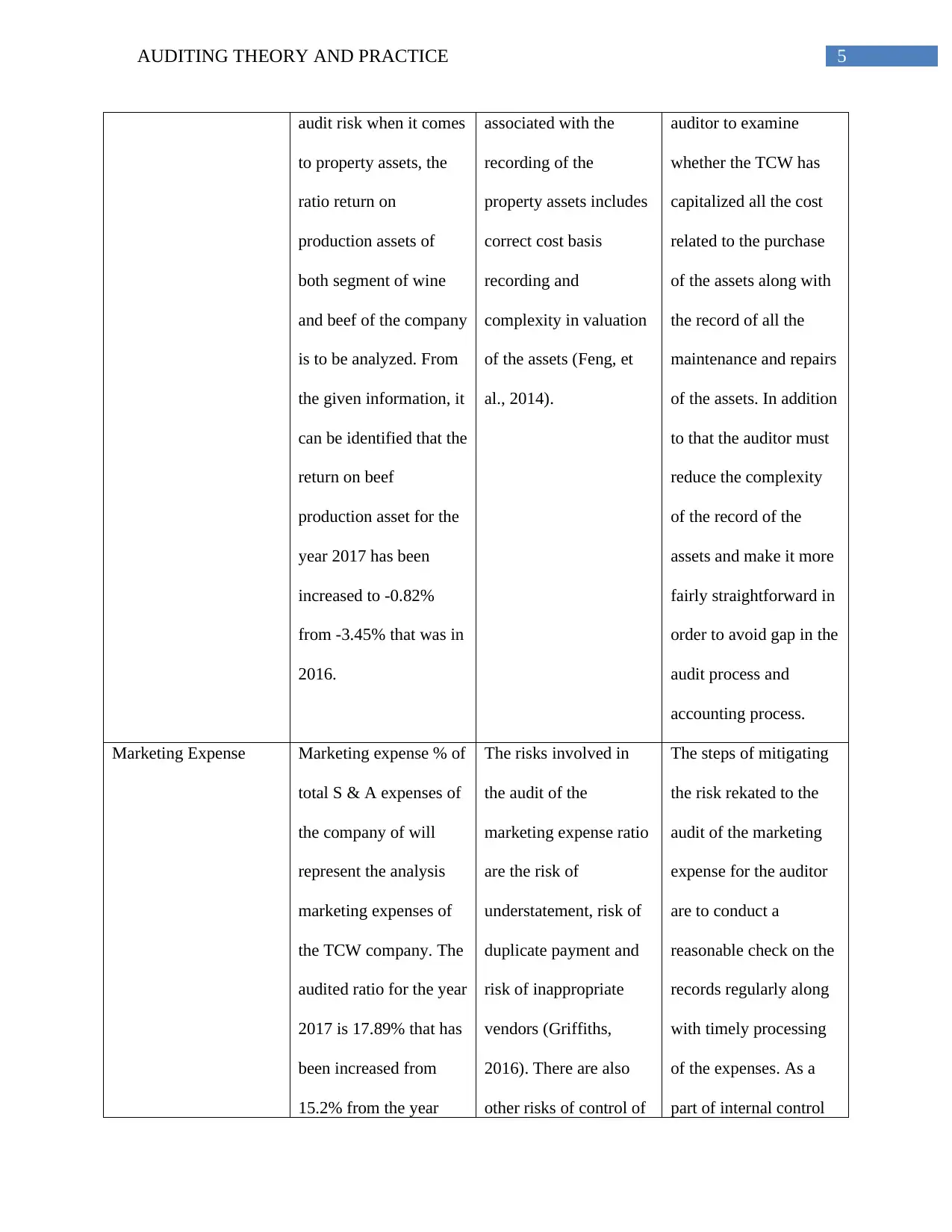
5AUDITING THEORY AND PRACTICE
audit risk when it comes
to property assets, the
ratio return on
production assets of
both segment of wine
and beef of the company
is to be analyzed. From
the given information, it
can be identified that the
return on beef
production asset for the
year 2017 has been
increased to -0.82%
from -3.45% that was in
2016.
associated with the
recording of the
property assets includes
correct cost basis
recording and
complexity in valuation
of the assets (Feng, et
al., 2014).
auditor to examine
whether the TCW has
capitalized all the cost
related to the purchase
of the assets along with
the record of all the
maintenance and repairs
of the assets. In addition
to that the auditor must
reduce the complexity
of the record of the
assets and make it more
fairly straightforward in
order to avoid gap in the
audit process and
accounting process.
Marketing Expense Marketing expense % of
total S & A expenses of
the company of will
represent the analysis
marketing expenses of
the TCW company. The
audited ratio for the year
2017 is 17.89% that has
been increased from
15.2% from the year
The risks involved in
the audit of the
marketing expense ratio
are the risk of
understatement, risk of
duplicate payment and
risk of inappropriate
vendors (Griffiths,
2016). There are also
other risks of control of
The steps of mitigating
the risk rekated to the
audit of the marketing
expense for the auditor
are to conduct a
reasonable check on the
records regularly along
with timely processing
of the expenses. As a
part of internal control
audit risk when it comes
to property assets, the
ratio return on
production assets of
both segment of wine
and beef of the company
is to be analyzed. From
the given information, it
can be identified that the
return on beef
production asset for the
year 2017 has been
increased to -0.82%
from -3.45% that was in
2016.
associated with the
recording of the
property assets includes
correct cost basis
recording and
complexity in valuation
of the assets (Feng, et
al., 2014).
auditor to examine
whether the TCW has
capitalized all the cost
related to the purchase
of the assets along with
the record of all the
maintenance and repairs
of the assets. In addition
to that the auditor must
reduce the complexity
of the record of the
assets and make it more
fairly straightforward in
order to avoid gap in the
audit process and
accounting process.
Marketing Expense Marketing expense % of
total S & A expenses of
the company of will
represent the analysis
marketing expenses of
the TCW company. The
audited ratio for the year
2017 is 17.89% that has
been increased from
15.2% from the year
The risks involved in
the audit of the
marketing expense ratio
are the risk of
understatement, risk of
duplicate payment and
risk of inappropriate
vendors (Griffiths,
2016). There are also
other risks of control of
The steps of mitigating
the risk rekated to the
audit of the marketing
expense for the auditor
are to conduct a
reasonable check on the
records regularly along
with timely processing
of the expenses. As a
part of internal control
⊘ This is a preview!⊘
Do you want full access?
Subscribe today to unlock all pages.

Trusted by 1+ million students worldwide
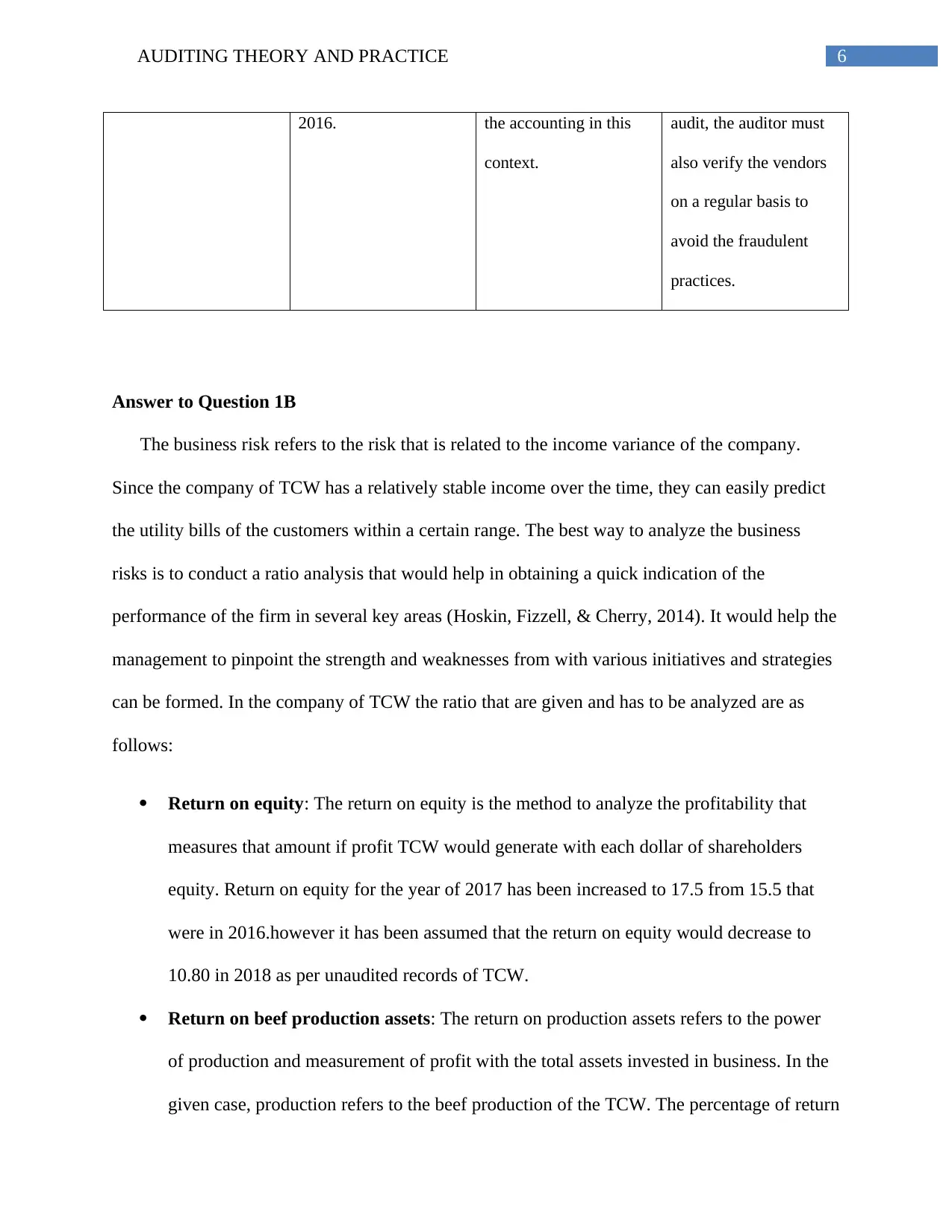
6AUDITING THEORY AND PRACTICE
2016. the accounting in this
context.
audit, the auditor must
also verify the vendors
on a regular basis to
avoid the fraudulent
practices.
Answer to Question 1B
The business risk refers to the risk that is related to the income variance of the company.
Since the company of TCW has a relatively stable income over the time, they can easily predict
the utility bills of the customers within a certain range. The best way to analyze the business
risks is to conduct a ratio analysis that would help in obtaining a quick indication of the
performance of the firm in several key areas (Hoskin, Fizzell, & Cherry, 2014). It would help the
management to pinpoint the strength and weaknesses from with various initiatives and strategies
can be formed. In the company of TCW the ratio that are given and has to be analyzed are as
follows:
Return on equity: The return on equity is the method to analyze the profitability that
measures that amount if profit TCW would generate with each dollar of shareholders
equity. Return on equity for the year of 2017 has been increased to 17.5 from 15.5 that
were in 2016.however it has been assumed that the return on equity would decrease to
10.80 in 2018 as per unaudited records of TCW.
Return on beef production assets: The return on production assets refers to the power
of production and measurement of profit with the total assets invested in business. In the
given case, production refers to the beef production of the TCW. The percentage of return
2016. the accounting in this
context.
audit, the auditor must
also verify the vendors
on a regular basis to
avoid the fraudulent
practices.
Answer to Question 1B
The business risk refers to the risk that is related to the income variance of the company.
Since the company of TCW has a relatively stable income over the time, they can easily predict
the utility bills of the customers within a certain range. The best way to analyze the business
risks is to conduct a ratio analysis that would help in obtaining a quick indication of the
performance of the firm in several key areas (Hoskin, Fizzell, & Cherry, 2014). It would help the
management to pinpoint the strength and weaknesses from with various initiatives and strategies
can be formed. In the company of TCW the ratio that are given and has to be analyzed are as
follows:
Return on equity: The return on equity is the method to analyze the profitability that
measures that amount if profit TCW would generate with each dollar of shareholders
equity. Return on equity for the year of 2017 has been increased to 17.5 from 15.5 that
were in 2016.however it has been assumed that the return on equity would decrease to
10.80 in 2018 as per unaudited records of TCW.
Return on beef production assets: The return on production assets refers to the power
of production and measurement of profit with the total assets invested in business. In the
given case, production refers to the beef production of the TCW. The percentage of return
Paraphrase This Document
Need a fresh take? Get an instant paraphrase of this document with our AI Paraphraser
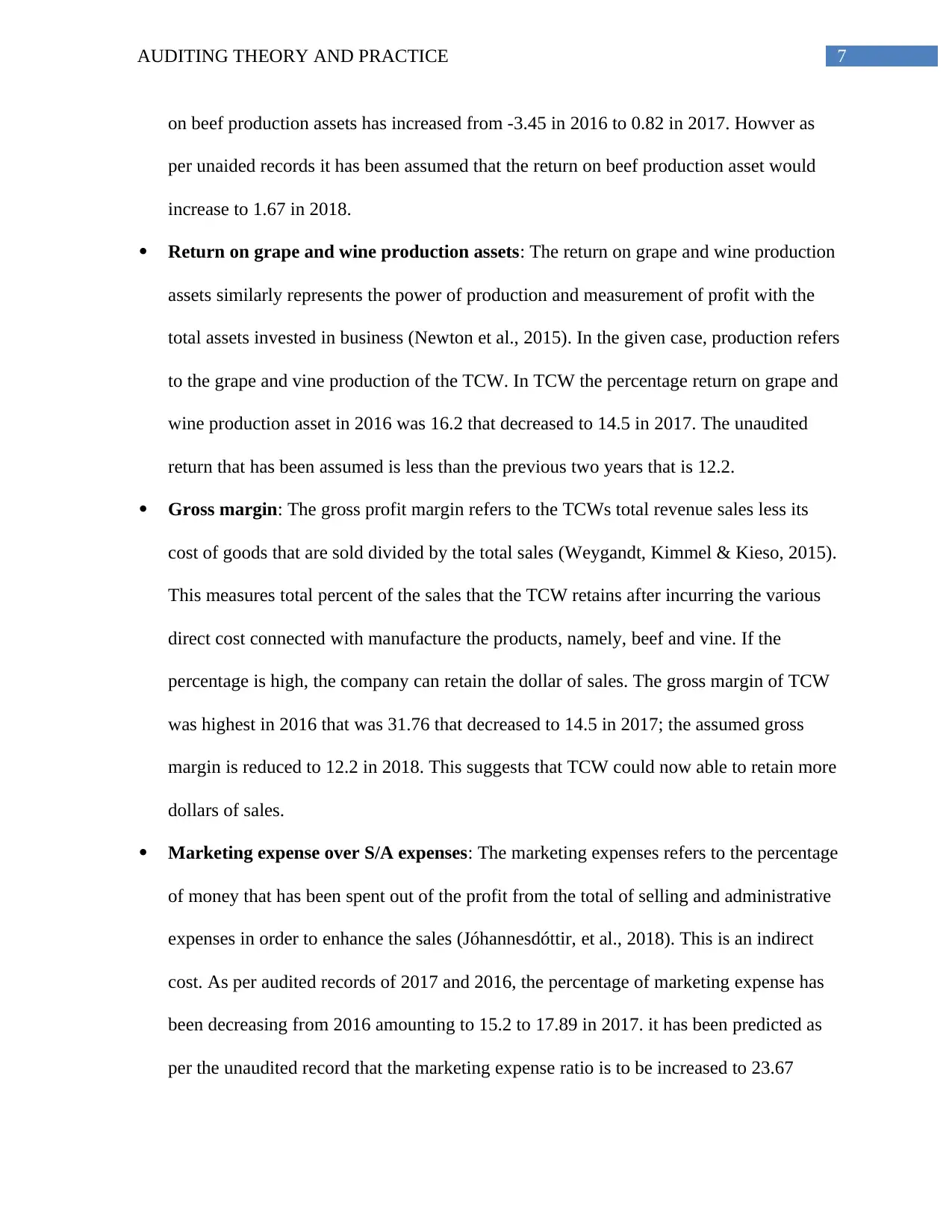
7AUDITING THEORY AND PRACTICE
on beef production assets has increased from -3.45 in 2016 to 0.82 in 2017. Howver as
per unaided records it has been assumed that the return on beef production asset would
increase to 1.67 in 2018.
Return on grape and wine production assets: The return on grape and wine production
assets similarly represents the power of production and measurement of profit with the
total assets invested in business (Newton et al., 2015). In the given case, production refers
to the grape and vine production of the TCW. In TCW the percentage return on grape and
wine production asset in 2016 was 16.2 that decreased to 14.5 in 2017. The unaudited
return that has been assumed is less than the previous two years that is 12.2.
Gross margin: The gross profit margin refers to the TCWs total revenue sales less its
cost of goods that are sold divided by the total sales (Weygandt, Kimmel & Kieso, 2015).
This measures total percent of the sales that the TCW retains after incurring the various
direct cost connected with manufacture the products, namely, beef and vine. If the
percentage is high, the company can retain the dollar of sales. The gross margin of TCW
was highest in 2016 that was 31.76 that decreased to 14.5 in 2017; the assumed gross
margin is reduced to 12.2 in 2018. This suggests that TCW could now able to retain more
dollars of sales.
Marketing expense over S/A expenses: The marketing expenses refers to the percentage
of money that has been spent out of the profit from the total of selling and administrative
expenses in order to enhance the sales (Jóhannesdóttir, et al., 2018). This is an indirect
cost. As per audited records of 2017 and 2016, the percentage of marketing expense has
been decreasing from 2016 amounting to 15.2 to 17.89 in 2017. it has been predicted as
per the unaudited record that the marketing expense ratio is to be increased to 23.67
on beef production assets has increased from -3.45 in 2016 to 0.82 in 2017. Howver as
per unaided records it has been assumed that the return on beef production asset would
increase to 1.67 in 2018.
Return on grape and wine production assets: The return on grape and wine production
assets similarly represents the power of production and measurement of profit with the
total assets invested in business (Newton et al., 2015). In the given case, production refers
to the grape and vine production of the TCW. In TCW the percentage return on grape and
wine production asset in 2016 was 16.2 that decreased to 14.5 in 2017. The unaudited
return that has been assumed is less than the previous two years that is 12.2.
Gross margin: The gross profit margin refers to the TCWs total revenue sales less its
cost of goods that are sold divided by the total sales (Weygandt, Kimmel & Kieso, 2015).
This measures total percent of the sales that the TCW retains after incurring the various
direct cost connected with manufacture the products, namely, beef and vine. If the
percentage is high, the company can retain the dollar of sales. The gross margin of TCW
was highest in 2016 that was 31.76 that decreased to 14.5 in 2017; the assumed gross
margin is reduced to 12.2 in 2018. This suggests that TCW could now able to retain more
dollars of sales.
Marketing expense over S/A expenses: The marketing expenses refers to the percentage
of money that has been spent out of the profit from the total of selling and administrative
expenses in order to enhance the sales (Jóhannesdóttir, et al., 2018). This is an indirect
cost. As per audited records of 2017 and 2016, the percentage of marketing expense has
been decreasing from 2016 amounting to 15.2 to 17.89 in 2017. it has been predicted as
per the unaudited record that the marketing expense ratio is to be increased to 23.67
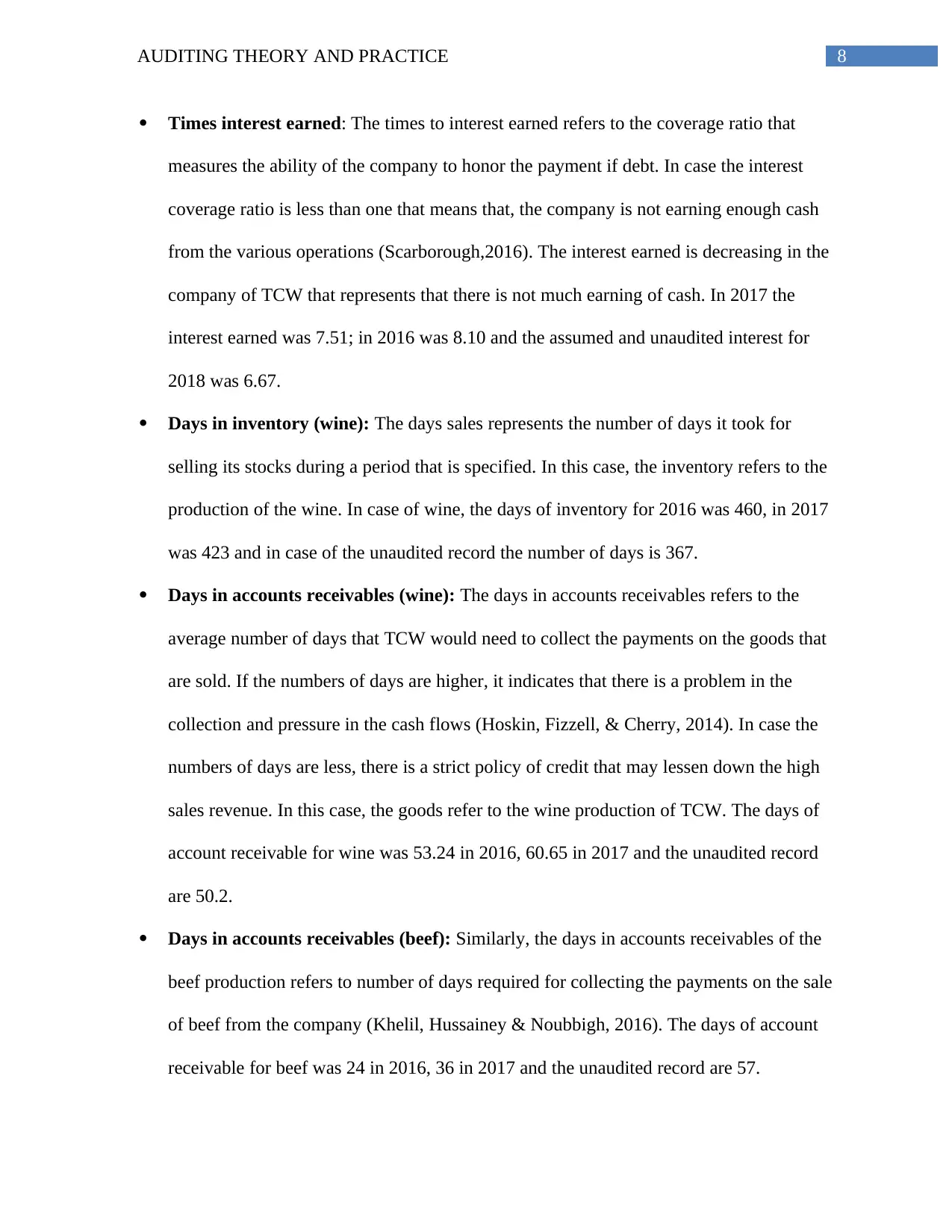
8AUDITING THEORY AND PRACTICE
Times interest earned: The times to interest earned refers to the coverage ratio that
measures the ability of the company to honor the payment if debt. In case the interest
coverage ratio is less than one that means that, the company is not earning enough cash
from the various operations (Scarborough,2016). The interest earned is decreasing in the
company of TCW that represents that there is not much earning of cash. In 2017 the
interest earned was 7.51; in 2016 was 8.10 and the assumed and unaudited interest for
2018 was 6.67.
Days in inventory (wine): The days sales represents the number of days it took for
selling its stocks during a period that is specified. In this case, the inventory refers to the
production of the wine. In case of wine, the days of inventory for 2016 was 460, in 2017
was 423 and in case of the unaudited record the number of days is 367.
Days in accounts receivables (wine): The days in accounts receivables refers to the
average number of days that TCW would need to collect the payments on the goods that
are sold. If the numbers of days are higher, it indicates that there is a problem in the
collection and pressure in the cash flows (Hoskin, Fizzell, & Cherry, 2014). In case the
numbers of days are less, there is a strict policy of credit that may lessen down the high
sales revenue. In this case, the goods refer to the wine production of TCW. The days of
account receivable for wine was 53.24 in 2016, 60.65 in 2017 and the unaudited record
are 50.2.
Days in accounts receivables (beef): Similarly, the days in accounts receivables of the
beef production refers to number of days required for collecting the payments on the sale
of beef from the company (Khelil, Hussainey & Noubbigh, 2016). The days of account
receivable for beef was 24 in 2016, 36 in 2017 and the unaudited record are 57.
Times interest earned: The times to interest earned refers to the coverage ratio that
measures the ability of the company to honor the payment if debt. In case the interest
coverage ratio is less than one that means that, the company is not earning enough cash
from the various operations (Scarborough,2016). The interest earned is decreasing in the
company of TCW that represents that there is not much earning of cash. In 2017 the
interest earned was 7.51; in 2016 was 8.10 and the assumed and unaudited interest for
2018 was 6.67.
Days in inventory (wine): The days sales represents the number of days it took for
selling its stocks during a period that is specified. In this case, the inventory refers to the
production of the wine. In case of wine, the days of inventory for 2016 was 460, in 2017
was 423 and in case of the unaudited record the number of days is 367.
Days in accounts receivables (wine): The days in accounts receivables refers to the
average number of days that TCW would need to collect the payments on the goods that
are sold. If the numbers of days are higher, it indicates that there is a problem in the
collection and pressure in the cash flows (Hoskin, Fizzell, & Cherry, 2014). In case the
numbers of days are less, there is a strict policy of credit that may lessen down the high
sales revenue. In this case, the goods refer to the wine production of TCW. The days of
account receivable for wine was 53.24 in 2016, 60.65 in 2017 and the unaudited record
are 50.2.
Days in accounts receivables (beef): Similarly, the days in accounts receivables of the
beef production refers to number of days required for collecting the payments on the sale
of beef from the company (Khelil, Hussainey & Noubbigh, 2016). The days of account
receivable for beef was 24 in 2016, 36 in 2017 and the unaudited record are 57.
⊘ This is a preview!⊘
Do you want full access?
Subscribe today to unlock all pages.

Trusted by 1+ million students worldwide
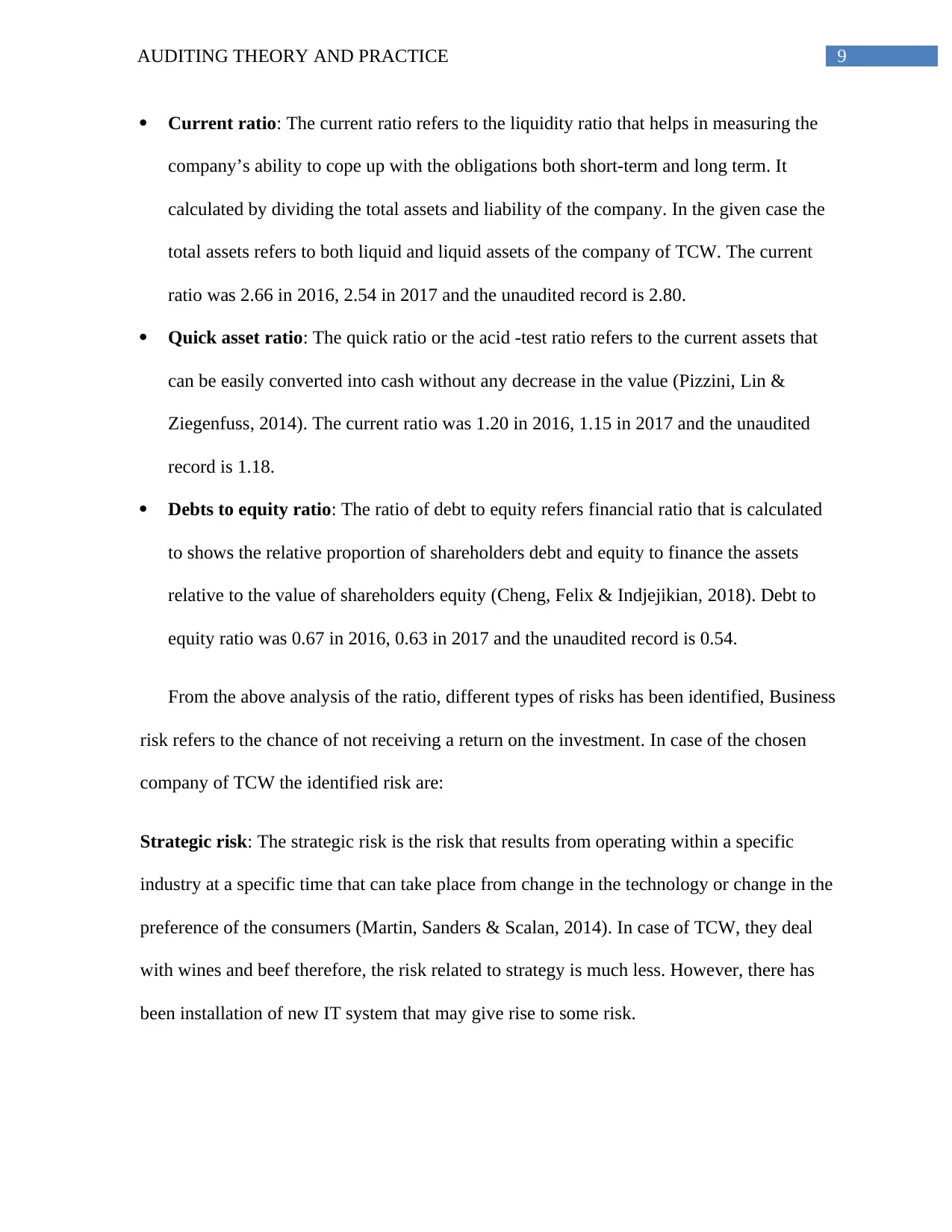
9AUDITING THEORY AND PRACTICE
Current ratio: The current ratio refers to the liquidity ratio that helps in measuring the
company’s ability to cope up with the obligations both short-term and long term. It
calculated by dividing the total assets and liability of the company. In the given case the
total assets refers to both liquid and liquid assets of the company of TCW. The current
ratio was 2.66 in 2016, 2.54 in 2017 and the unaudited record is 2.80.
Quick asset ratio: The quick ratio or the acid -test ratio refers to the current assets that
can be easily converted into cash without any decrease in the value (Pizzini, Lin &
Ziegenfuss, 2014). The current ratio was 1.20 in 2016, 1.15 in 2017 and the unaudited
record is 1.18.
Debts to equity ratio: The ratio of debt to equity refers financial ratio that is calculated
to shows the relative proportion of shareholders debt and equity to finance the assets
relative to the value of shareholders equity (Cheng, Felix & Indjejikian, 2018). Debt to
equity ratio was 0.67 in 2016, 0.63 in 2017 and the unaudited record is 0.54.
From the above analysis of the ratio, different types of risks has been identified, Business
risk refers to the chance of not receiving a return on the investment. In case of the chosen
company of TCW the identified risk are:
Strategic risk: The strategic risk is the risk that results from operating within a specific
industry at a specific time that can take place from change in the technology or change in the
preference of the consumers (Martin, Sanders & Scalan, 2014). In case of TCW, they deal
with wines and beef therefore, the risk related to strategy is much less. However, there has
been installation of new IT system that may give rise to some risk.
Current ratio: The current ratio refers to the liquidity ratio that helps in measuring the
company’s ability to cope up with the obligations both short-term and long term. It
calculated by dividing the total assets and liability of the company. In the given case the
total assets refers to both liquid and liquid assets of the company of TCW. The current
ratio was 2.66 in 2016, 2.54 in 2017 and the unaudited record is 2.80.
Quick asset ratio: The quick ratio or the acid -test ratio refers to the current assets that
can be easily converted into cash without any decrease in the value (Pizzini, Lin &
Ziegenfuss, 2014). The current ratio was 1.20 in 2016, 1.15 in 2017 and the unaudited
record is 1.18.
Debts to equity ratio: The ratio of debt to equity refers financial ratio that is calculated
to shows the relative proportion of shareholders debt and equity to finance the assets
relative to the value of shareholders equity (Cheng, Felix & Indjejikian, 2018). Debt to
equity ratio was 0.67 in 2016, 0.63 in 2017 and the unaudited record is 0.54.
From the above analysis of the ratio, different types of risks has been identified, Business
risk refers to the chance of not receiving a return on the investment. In case of the chosen
company of TCW the identified risk are:
Strategic risk: The strategic risk is the risk that results from operating within a specific
industry at a specific time that can take place from change in the technology or change in the
preference of the consumers (Martin, Sanders & Scalan, 2014). In case of TCW, they deal
with wines and beef therefore, the risk related to strategy is much less. However, there has
been installation of new IT system that may give rise to some risk.
Paraphrase This Document
Need a fresh take? Get an instant paraphrase of this document with our AI Paraphraser
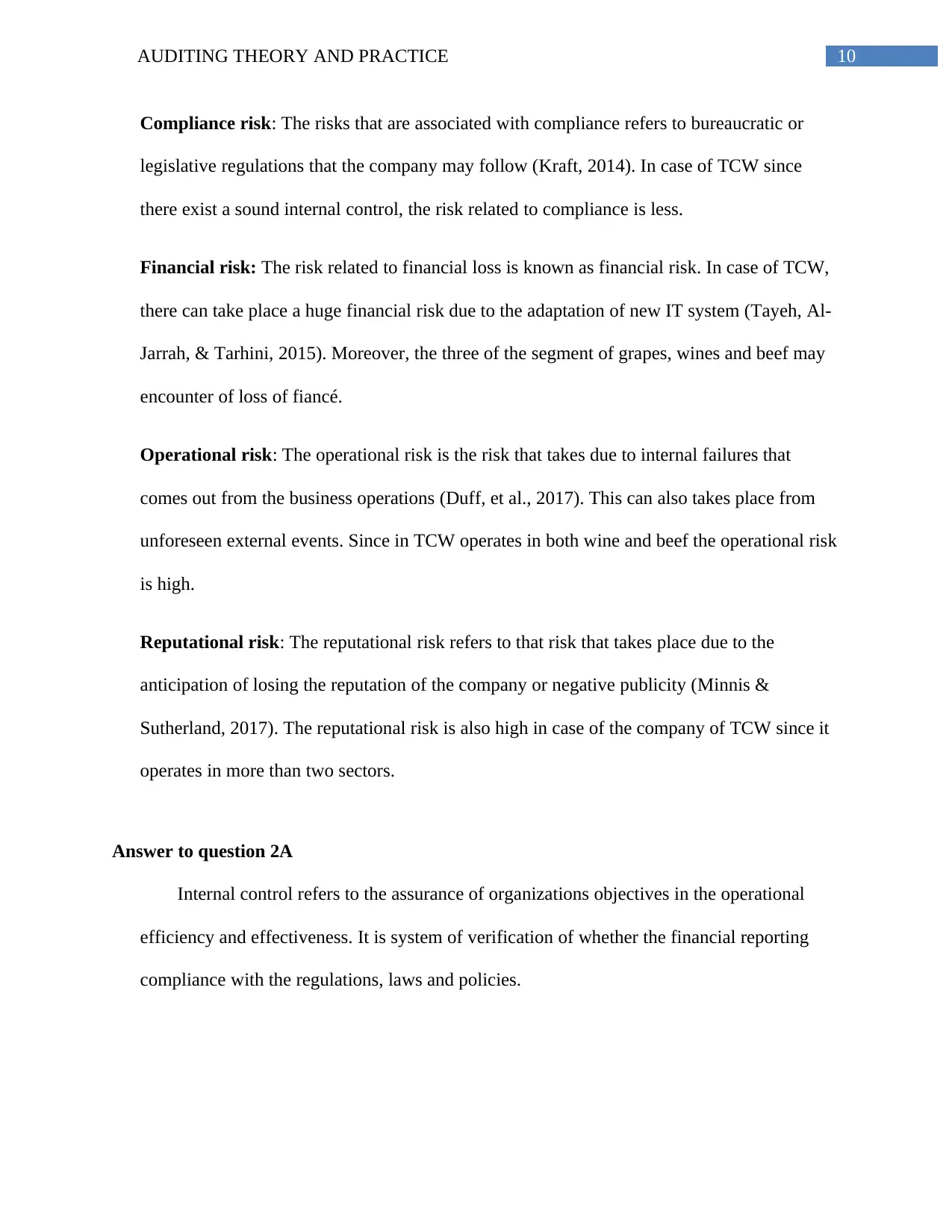
10AUDITING THEORY AND PRACTICE
Compliance risk: The risks that are associated with compliance refers to bureaucratic or
legislative regulations that the company may follow (Kraft, 2014). In case of TCW since
there exist a sound internal control, the risk related to compliance is less.
Financial risk: The risk related to financial loss is known as financial risk. In case of TCW,
there can take place a huge financial risk due to the adaptation of new IT system (Tayeh, Al-
Jarrah, & Tarhini, 2015). Moreover, the three of the segment of grapes, wines and beef may
encounter of loss of fiancé.
Operational risk: The operational risk is the risk that takes due to internal failures that
comes out from the business operations (Duff, et al., 2017). This can also takes place from
unforeseen external events. Since in TCW operates in both wine and beef the operational risk
is high.
Reputational risk: The reputational risk refers to that risk that takes place due to the
anticipation of losing the reputation of the company or negative publicity (Minnis &
Sutherland, 2017). The reputational risk is also high in case of the company of TCW since it
operates in more than two sectors.
Answer to question 2A
Internal control refers to the assurance of organizations objectives in the operational
efficiency and effectiveness. It is system of verification of whether the financial reporting
compliance with the regulations, laws and policies.
Compliance risk: The risks that are associated with compliance refers to bureaucratic or
legislative regulations that the company may follow (Kraft, 2014). In case of TCW since
there exist a sound internal control, the risk related to compliance is less.
Financial risk: The risk related to financial loss is known as financial risk. In case of TCW,
there can take place a huge financial risk due to the adaptation of new IT system (Tayeh, Al-
Jarrah, & Tarhini, 2015). Moreover, the three of the segment of grapes, wines and beef may
encounter of loss of fiancé.
Operational risk: The operational risk is the risk that takes due to internal failures that
comes out from the business operations (Duff, et al., 2017). This can also takes place from
unforeseen external events. Since in TCW operates in both wine and beef the operational risk
is high.
Reputational risk: The reputational risk refers to that risk that takes place due to the
anticipation of losing the reputation of the company or negative publicity (Minnis &
Sutherland, 2017). The reputational risk is also high in case of the company of TCW since it
operates in more than two sectors.
Answer to question 2A
Internal control refers to the assurance of organizations objectives in the operational
efficiency and effectiveness. It is system of verification of whether the financial reporting
compliance with the regulations, laws and policies.
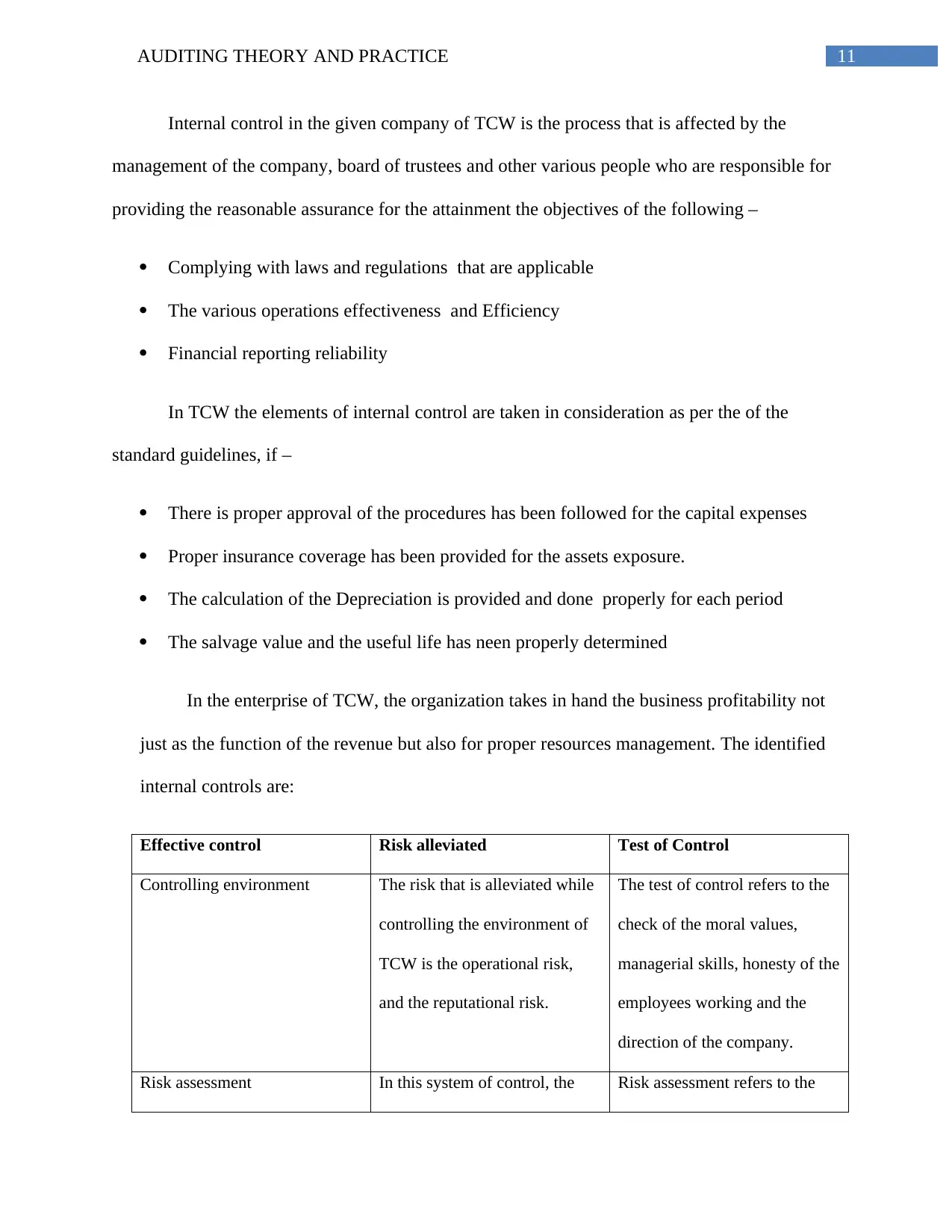
11AUDITING THEORY AND PRACTICE
Internal control in the given company of TCW is the process that is affected by the
management of the company, board of trustees and other various people who are responsible for
providing the reasonable assurance for the attainment the objectives of the following –
Complying with laws and regulations that are applicable
The various operations effectiveness and Efficiency
Financial reporting reliability
In TCW the elements of internal control are taken in consideration as per the of the
standard guidelines, if –
There is proper approval of the procedures has been followed for the capital expenses
Proper insurance coverage has been provided for the assets exposure.
The calculation of the Depreciation is provided and done properly for each period
The salvage value and the useful life has neen properly determined
In the enterprise of TCW, the organization takes in hand the business profitability not
just as the function of the revenue but also for proper resources management. The identified
internal controls are:
Effective control Risk alleviated Test of Control
Controlling environment The risk that is alleviated while
controlling the environment of
TCW is the operational risk,
and the reputational risk.
The test of control refers to the
check of the moral values,
managerial skills, honesty of the
employees working and the
direction of the company.
Risk assessment In this system of control, the Risk assessment refers to the
Internal control in the given company of TCW is the process that is affected by the
management of the company, board of trustees and other various people who are responsible for
providing the reasonable assurance for the attainment the objectives of the following –
Complying with laws and regulations that are applicable
The various operations effectiveness and Efficiency
Financial reporting reliability
In TCW the elements of internal control are taken in consideration as per the of the
standard guidelines, if –
There is proper approval of the procedures has been followed for the capital expenses
Proper insurance coverage has been provided for the assets exposure.
The calculation of the Depreciation is provided and done properly for each period
The salvage value and the useful life has neen properly determined
In the enterprise of TCW, the organization takes in hand the business profitability not
just as the function of the revenue but also for proper resources management. The identified
internal controls are:
Effective control Risk alleviated Test of Control
Controlling environment The risk that is alleviated while
controlling the environment of
TCW is the operational risk,
and the reputational risk.
The test of control refers to the
check of the moral values,
managerial skills, honesty of the
employees working and the
direction of the company.
Risk assessment In this system of control, the Risk assessment refers to the
⊘ This is a preview!⊘
Do you want full access?
Subscribe today to unlock all pages.

Trusted by 1+ million students worldwide
1 out of 18
Related Documents
Your All-in-One AI-Powered Toolkit for Academic Success.
+13062052269
info@desklib.com
Available 24*7 on WhatsApp / Email
![[object Object]](/_next/static/media/star-bottom.7253800d.svg)
Unlock your academic potential
Copyright © 2020–2025 A2Z Services. All Rights Reserved. Developed and managed by ZUCOL.




